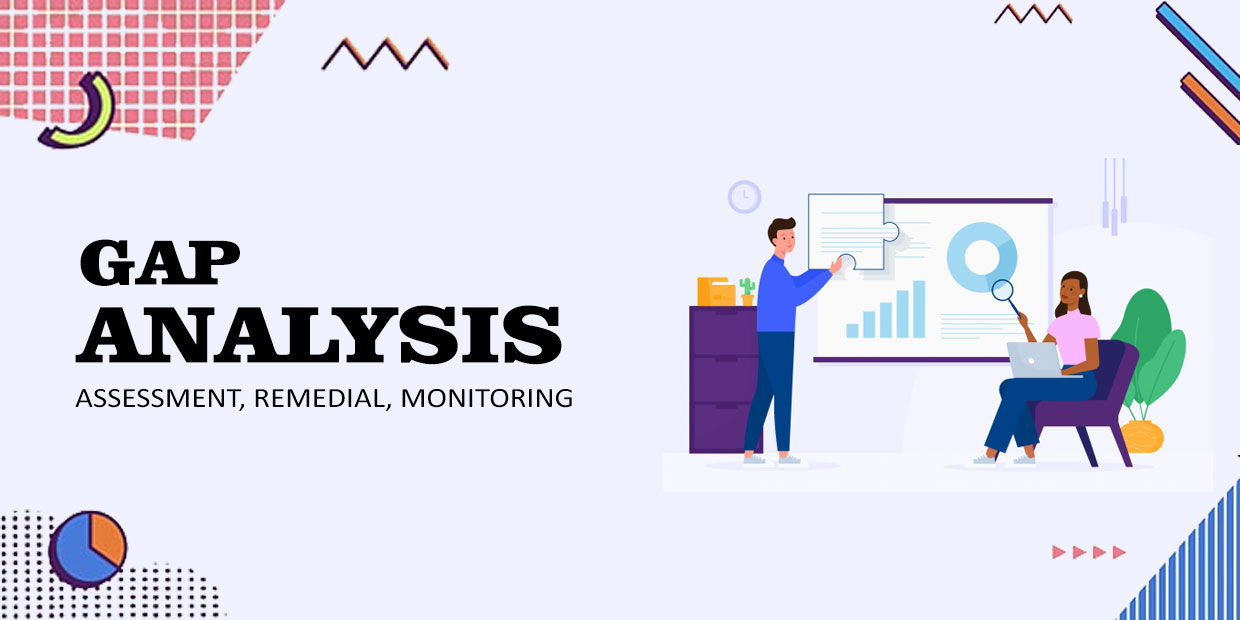What is Gap Analysis: Importance, Benefits and Guide
Get Your Free Trial Now!
Discover the power of gap analysis – a method that assesses how well a business unit is performing in meeting its objectives. It helps determine if business needs are being fulfilled and guides the formulation of steps to ensure they are.
In simpler terms, gap analysis is also known as needs analysis, needs assessment, or needs-gap analysis. It acts as a valuable tool for businesses in India to evaluate their performance and align with their goals. The term "gap" in this process signifies the space between the current state ("where we are") and the desired state or target state ("where we want to be")

Navigating Educational Success: A Guide to Conducting Gap Analysis

Embarking on a gap analysis journey begins with setting precise goal objectives. Delve into the company's mission statement, strategic business goals, and improvement objectives to establish a clear direction.
Following this, delve into the analysis of current processes by gathering relevant data on performance levels and resource allocation. Data collection methods vary, including examining documentation, measuring key performance indicators (KPIs), conducting stakeholder interviews, brainstorming, and observing project activities.
As the company aligns its intended goals with the present scenario, a comprehensive plan takes shape. This plan serves as a roadmap, detailing step-by-step processes to bridge the gap between the current and future situations, aiming to achieve the target objectives. This strategic planning phase plays a pivotal role in charting the course for educational success.
Understanding Gap Analysis Components
While methods for gap analysis can take concrete or conceptual forms, gap analysis templates typically share common components. In the educational context, organizations often find themselves underutilizing resources, capital, and technology, hindering their ability to achieve full potential. This is precisely where gap analysis becomes a valuable tool.
Gap analysis, also known as needs analysis, plays a pivotal role in organizational performance across various sectors, including education. It enables educational institutions to understand their current status and envision their future. Through gap analysis, institutions can reassess their goals and track their progress towards achieving them.
Originally prominent in the 1980s, gap analysis was frequently employed alongside period analysis. While duration analysis is considered more challenging and less widely used, it still proves effective in evaluating the risk associated with various term structure movements.
1. Current State:
A gap analysis template typically initiates with a column labeled "Current Status." It articulates the processes, workflows, and features an organization aims to enhance, utilizing precise and factual descriptions. The scope can range from broad, encompassing the entire business, to narrow, focusing on specific processes, aligning with the company's objectives.
2. Future State:
The gap analysis report must include a column titled "Future State," outlining the target objectives. This section can be expressed in concrete, quantitative terms or more general statements, depending on the company's goals. For instance, it might set specific targets, such as increasing customer calls by a certain percentage, or aspire towards fostering a more inclusive workplace culture.
3. Gap Description:
This column identifies whether a gap exists between the current and future states. If so, it outlines the nature of the gap and its root causes in clear, objective terms. Factors contributing to the gap can be either quantitative (e.g., lack of diversity programs) or qualitative (e.g., disparities in call handling numbers).
4. Next Steps and Proposals:
The final column lists potential solutions to bridge the identified gap. These proposals should directly address factors mentioned in the gap description, with clear objectives and a specified timeframe. Examples include hiring additional staff for customer calls, implementing call volume reporting, and launching diversity programs.
Importance of gap analysis
Identification of Improvement Areas:
Pinpointing areas in processes, products, or services that need enhancement.
Strategic Planning for Bridging Gaps:
Developing effective plans to bridge the gap between aspirations and current actions.
Prioritization and Resource Allocation:
Assisting in setting priorities and allocating resources efficiently.
Ensuring Compliance with Rules:
Identifying areas requiring greater compliance to ensure adherence to rules and regulations.
Performance Enhancement and Cost Reduction:
Contributing to improved performance, enhanced efficiency, and cost-cutting measures.
Data-Driven Decision-Making:
Enabling informed decision-making through data-driven insights.
Identifying Growth Opportunities:
Uncovering opportunities for growth and expansion by addressing market gaps and customer needs.
Tracking Improvement Initiatives:
Monitoring the effectiveness of improvement initiatives over time for ongoing assessment.
Driving Business Success:
Serving as a valuable tool for businesses aspiring to boost performance, achieve objectives, and enhance productivity.
Strategic Benefits of Gap Analysis
As gap analysis finds versatile applications, it unfolds a spectrum of advantages, each tailored to specific types of interval analysis. Indian companies engaging in gap analysis may
Enhanced Profitability:
Proactive gap assessment empowers companies to optimize spending, ensuring efficient resource utilization and strategic capital allocation, ultimately leading to improved profitability.
Streamlined Manufacturing Processes:
Identifying and mitigating delays in manufacturing fosters robust production, efficient logistics, timely availability of raw materials, and minimizes bottlenecks caused by process defects.
Market Share Expansion:
Integrating insights from gap analysis results in an enhanced market presence, boosting sales, revenue, customer base, and overall market share.
Employee and Customer Satisfaction:
Addressing potential issues proactively, rather than reactively, fosters positive relationships with employees and customers, preventing strains and potential shifts to competitors.
Executive Skill Enhancement:
A nuanced understanding of operational challenges allows companies to make informed changes, thereby enhancing day-to-day operations and executive skills.
Mitigated Risks in Long-Term Ventures:
Identifying resource needs and potential deficiencies in advance enables companies to plan effectively, mitigating risks and addressing problems before they manifest in long-term endeavors.
Types of Gap Analysis
Leveraging Gap Analysis in the Indian Education Sector
Discover how the education industry in India is reaping the rewards of Gap Analysis. This strategic method assesses the performance of educational institutions, ensuring they meet their goals effectively. By identifying areas of improvement, institutions can take targeted steps to enhance the quality of education and bridge any gaps that may exist.
Market Gap Analysis: Meeting Customer Needs
Referred to as product gap analysis, this approach focuses on understanding the market and identifying areas where customer needs remain unmet. Companies can strategically fill these gaps by assessing product supply versus consumer demand. External consultants, with expertise in unexplored business areas, can aid in this analysis, providing valuable insights.
Strategic Gap Analysis: Evaluating Company Performance
Also known as performance gap analysis, this internal review assesses a company's performance against long-term benchmarks or competitors. By scrutinizing personnel and capital utilization, businesses can uncover strategic and resourceful practices. Obtaining such information may be challenging, especially if confidentiality agreements are in place, and the company doesn't disclose operational details publicly.
Financial/Profit Gap Analysis: Analyzing Financial Efficiency
Directly analyzing financial metrics, companies compare pricing, margins, overhead costs, and more to identify areas of financial inefficiency compared to competitors. This analysis aims to determine where rivals exhibit greater financial efficiency, guiding broader interval analysis strategies.
Skills Gap Analysis: Assessing Human Element
Focusing on the human aspect, skills gap analysis examines if current personnel possess the necessary knowledge and expertise. Essential for innovative and small companies, this analysis informs decisions on training existing employees or bringing in external expertise to maintain competitiveness.
Compliance Gap Analysis: Meeting External Rules
Leveraging internal audit functions, compliance gap analysis ensures adherence to external regulations. Unlike strategic gap analysis, its goal is preventive, avoiding fines, meeting reporting requirements, and ensuring successful compliance with external deadlines.
Product Development Gap Analysis: Adapting to Market Demands
Applied during product development, this analysis evaluates which aspects of a product meet market demands and where shortcomings may exist. Essential for software or long-term development projects, it tracks the progress of product implementation, alterations, and resource requirements.
Gap Analysis Tool: Streamlining the Assessment Process
Companies utilize various tools to facilitate gap analysis. Notably, the SWOT analysis stands out, examining Strengths, Weaknesses, Opportunities, and Threats, providing a comprehensive view of both internal and external factors for improvement.
When to use a gap analysis?
Gap analysis is a strategic tool that proves beneficial in various scenarios, helping businesses make informed decisions. Consider using gap analysis in the following situations
Process Enhancement:
When a business in India seeks to refine its operations, profit gap analysis can pinpoint inefficiencies or areas in performance that require attention.
Product Development:
Utilizing interval analysis ensures that the development of new products aligns with the needs and expectations of Indian customers.
Compliance and Risk Management:
In the Indian context, this analysis aids in identifying regulatory gaps, ensuring organizations adhere to all applicable laws and regulations.
Organizational Evolution:
Amid structural changes in a company, this research helps identify misalignments or gaps in skills, knowledge, or resources that demand attention
Performance Oversight:
In the Indian work environment, this analysis assists in pinpointing areas where employees, teams, or departments may underperform, facilitating the creation of plans for enhanced performance and productivity.